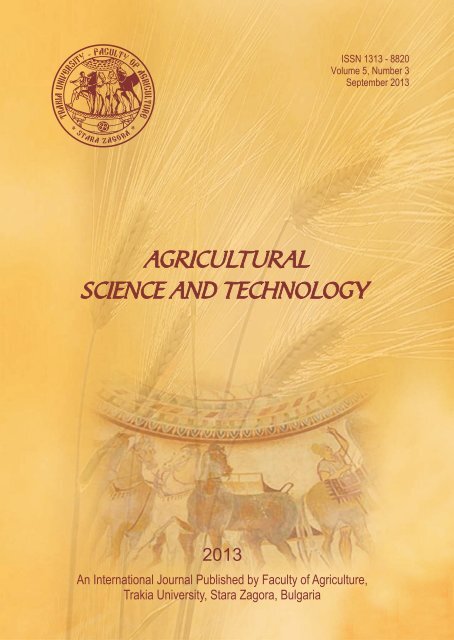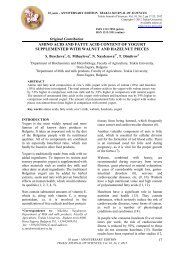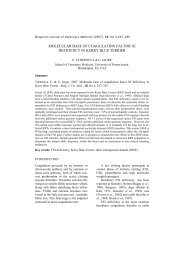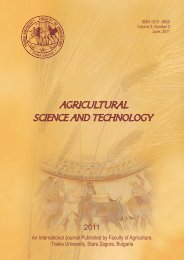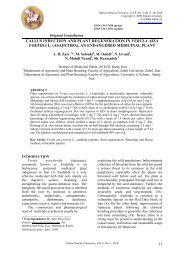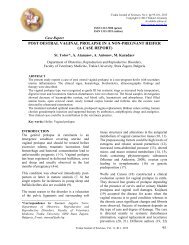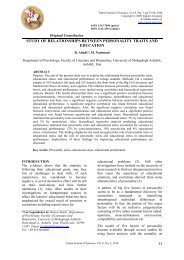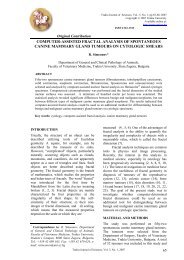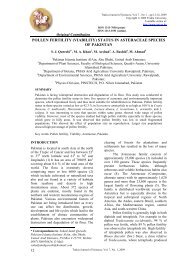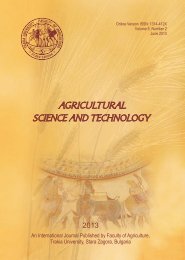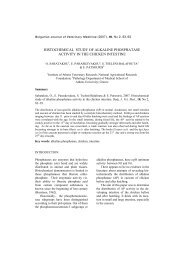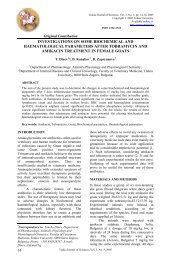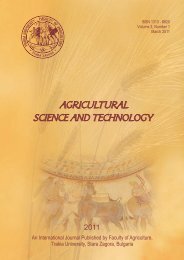Breeding evaluation of newly stabilized lines of maize
Breeding evaluation of newly stabilized lines of maize
Breeding evaluation of newly stabilized lines of maize
Create successful ePaper yourself
Turn your PDF publications into a flip-book with our unique Google optimized e-Paper software.
AGRICULTURAL SCIENCE AND TECHNOLOGY, VOL. 5, No 3, pp 257 - 260, 2013<strong>Breeding</strong> <strong>evaluation</strong> <strong>of</strong> <strong>newly</strong> <strong>stabilized</strong> <strong>lines</strong> <strong>of</strong> <strong>maize</strong>V. Valkova*Maize Research Institute, 5835 Knezha, BulgariaAbstract. General Combining Ability (GCA) and Specific Combining Ability (SCA) <strong>of</strong> sixteen <strong>newly</strong> <strong>stabilized</strong> early <strong>maize</strong> <strong>lines</strong> were evaluated by Savchenko'smethod (1978). The <strong>lines</strong> were tested in five testers by different genetic groups, possessing established high general combining ability. For testing <strong>of</strong> productivecapacity <strong>of</strong> the resulting F1 topcross crosses three preliminary variety trials were carried out in the experimental field <strong>of</strong> the Maize Research Institute, Knezha.The experimental work was carried out in the period <strong>of</strong> 2009–2011, under conditions without irrigation and plant density 52000 plant/ha. As a result <strong>of</strong> theseexperiments, inbred <strong>lines</strong> with high GCA are pointed out (KC 08 23 and KC 08 27), which are recommended as components <strong>of</strong> new synthetic populations. Thehighest is the SCA <strong>of</strong> inbred <strong>lines</strong> KC 08 31, KC 08 32 and XM 08 3. These inbreds may be used in heterosis programs for new high yield hybrid creation. Two <strong>of</strong>the <strong>lines</strong> (XM 08 1 and KC 08 24) have both high GCA and SCA and can be used in corresponding breeding programs.Keywords: <strong>maize</strong> <strong>lines</strong>, combining ability, grain yieldAbbreviations: CA – combining ability, GCA – general combining ability, SCA – specific combining ability, DES – Diethylsulfate, NEU – Nitroso-ethyl-ureaIntroductionon the fields <strong>of</strong> the Maize Research Institute, Knezha. Lines includedin the study were <strong>stabilized</strong> in 2008. Four <strong>of</strong> them (XM 08 1, XM 08 2,The success in heterosis breeding in <strong>maize</strong> depends mainly on XM 08 3 and XM 08 16) are product <strong>of</strong> the mutation breeding –properly selected parental forms for the hybridization. In their work obtained by treatment <strong>of</strong> heterozygous material <strong>of</strong> Diethylsulfateplant breeders choose the parental form based on: genetic distance (DES) – 0.1% and Nitroso-ethyl-urea ( NEU) – 0.001%, and<strong>of</strong> the <strong>lines</strong>, the complex <strong>of</strong> plant breeding valuable traits, vegetation <strong>stabilized</strong> in M 4 generation. The rest are made in the traditional way –period, resistance to diseases and insects, and last but not least, as “Pedigree” selection. In order to evaluate their CA, the <strong>lines</strong> areevaluated by their combining ability ( CA). CA characterizes the included in the topcross hybridization with five testers from differentbreeding value <strong>of</strong> each line. According to Hayes and Johnson (1939) genetic groups – Stiff Stalk Synthetic, Lancaster and Iodent.it is a genetically determined ability which is controlled by a large Crosses were derived in 2009 and tested in 2010 and 2011. Thenumber <strong>of</strong> genes with weak activity and is inherited both in selfrepetitions,a test plot <strong>of</strong> 5 m2, plant density 52000 plant/ha andtrials were carried out by the “Latin rectangle” method on twopollination and cross-pollination and depends on the conditions <strong>of</strong>the environment. For <strong>evaluation</strong> <strong>of</strong> CA a few system <strong>of</strong> crosses is without irrigation.applied – topcross, policross, diallele and setpross (Hritova, 1976; ANOVA was performed by Dimova and Marinkov (1999), andGenova, 1986; Ivanov, 1995; Ilchovska, 2003; Valkova, 2007; CA is assessed through the method <strong>of</strong> Savchenko (1966, 1978).Petrovska, 2012). Topcross is used in the initial stages <strong>of</strong> thebreeding test and allows quick and satisfactory valuation <strong>of</strong> CA <strong>of</strong> theresearch material (Savchenko, 1978). The success <strong>of</strong> its Results and discussionimplementation depends primarily on the correct test material andthe crossing <strong>of</strong> two or more analyzers increases the accuracy <strong>of</strong> the Agro-climatic characteristics <strong>of</strong> the region in the years <strong>of</strong>value. Combining valuable forms is included in the next stage - research include the mean monthly temperatures, the amount <strong>of</strong>diallele or setpross hybridization for testing GCA and SCA. In view <strong>of</strong> rainfall and the relative humidity <strong>of</strong> the air and values <strong>of</strong> the indicatorsthe above, the analysis and <strong>evaluation</strong> <strong>of</strong> CA on the breeder valuable for a 55-year period (Table 1). The two years differ substantiallytraits and characteristics <strong>of</strong> the source material (<strong>newly</strong> created <strong>lines</strong> neither in the temperature factor, nor in the relative humidity <strong>of</strong> the<strong>of</strong> <strong>maize</strong>) increases its efficiency as the selection process becomes air. The data show that the average temperature during themore focused, well-founded, greatly facilitates the selection <strong>of</strong> the vegetation period <strong>of</strong> <strong>maize</strong> in the first year <strong>of</strong> study was higher thancomponents in hybridization and allows breeders to continue their the ones in the 55-year period by 1°С and in the second year it waswork only on perspective forms.higher by 0.6°С. Temperatures are higher during the critical for theThe aim <strong>of</strong> the this study is to analyse CA for grain yield <strong>of</strong> new <strong>maize</strong> ontogenesis months July and August. Temperatures duringearly <strong>maize</strong> <strong>lines</strong> in terms <strong>of</strong> more direct use in different stages <strong>of</strong> the period 1931 – 1985 are 22.7°С and 22.0°С, respectively. In 2010heterosis selection.the values are 23.4°С and 24.5°С, and in 2011 – 22.7°С and22.8°С.Materials and methodsRelative humidity <strong>of</strong> the air was lower than the one during the55-year period (68.4%). In 2010 it was 59.6%, and in 2011 – 60.0%.The experimental work was carried out in the period 2009–2011 Much lower were the values <strong>of</strong> the indicator during the reproductive* e-mail: valkova_valentina@mail.bg257
Table 3. ANOVA <strong>of</strong> GCA and SCAYears20102011Sources <strong>of</strong> variation SQ FG S2 FFcritGCA sgiGCA sgjSCAErrorsGCA sgiGCA sgjSCAErrors825721430551789578523445404188402154607915460795504.8357642982.65682.31135131401.845611.9911.80963.6151.845611.9911.80963.6152Table 4. Effects <strong>of</strong> GCA (gi) and variances <strong>of</strong> SCA (σsi) for grain yield <strong>of</strong> early <strong>maize</strong> hybridsLinesKC 08 1XM 08 1XM 08 2XM 08 3KC 08 15KC 08 16XM 08 16KC 08 23KC 08 24KC 08 25KC 08 26KC 08 27KC 08 30KC 08 31KC 08 32KC 08 332010 2011 Mean2010201112.6459.58-37.00-32.26-52.74-7.2828.882.9856.46-8.68-4.9235.38-1.2010.14-39.68-22.36GCA4.3882.26-32.08-6.16-46.74-11.62-17.3221.3634.54-25.54-17.5433.36-20.88-16.7040.66-22.008.5170.92-34.54-19.21-49.74-9.455.7812.1745.50-17.11-11.2334.37-11.04-3.280.49-22.18552.544011.311924.35524.432027.34698.353486.551288.844175.81335.832412.612558.621737.625486.156736.441782.4SCA4066.552404.261063.492983.044394.521121.961464.732974.889858.06577.95530.261808.552503.035596.074098.922654.16Mean2309.553207.791493.904253.743210.93910.162475.642131.867016.94456.891471.442183.592120.335541.115417.682218.28(SCA). That allows to continue the analysis <strong>of</strong> CA for grain yield and As an <strong>evaluation</strong> criterion <strong>of</strong> the SCA <strong>lines</strong> the variations in thethe resulting proposals for application <strong>of</strong> the test material (Table 3). effects <strong>of</strong> their SCA are used. The data in table 4 show that КС 08 24,The effects <strong>of</strong> GCA and the variations <strong>of</strong> the effects <strong>of</strong> SCA were КС 08 31, КС 08 32 and ХМ 08 3 have the highest SCA from the trialused as <strong>evaluation</strong> criterion (Table 4). In the two years <strong>of</strong> study KC 08 <strong>lines</strong> for grain yield, while КС 08 25 and КС 08 16 are with the lowest23 KC 08 24 and KC 08 27 showed positive and high values <strong>of</strong> the SCA, respectively. These <strong>lines</strong> are suitable for including intoeffects <strong>of</strong> GCA for grain yield from the <strong>lines</strong> obtained by the classical heterosys programs upon receiving high-yield corn hybrids <strong>of</strong> thismethod and from the <strong>lines</strong> produced by the method <strong>of</strong> chemical maturity group. Especially valuable in terms <strong>of</strong> selection are <strong>lines</strong> ХМmutagenesis – XM 08 1. Since GCA is determined by additively 08 1 and КС 08 24, which combine both high general and highacting genes (Griffing, 1956; Turbin et al., 1974), these <strong>lines</strong> may be specific combining ability, indicating that they have goodused as components for the creation <strong>of</strong> early synthetics or testers for combination <strong>of</strong> productivity genes.analysis <strong>of</strong> the GCA <strong>of</strong> <strong>lines</strong> in the earlier stages <strong>of</strong> the selectionprocess.Opposite manifestation <strong>of</strong> GCA was observed in <strong>lines</strong> ХМ 08 16,КС 08 31 and КС 08 32. The observed instability in the manifestation Conclusion<strong>of</strong> GCA is not unusual, because the involved <strong>lines</strong> were <strong>newly</strong><strong>stabilized</strong> and did not pass any preliminary selection. These results Suitable <strong>lines</strong> for creating early synthetics are KC 08 23 and KC<strong>of</strong> ours support the findings made by Sotchenko (1970), according to 08 27. They can be used as tester GCA in the early stages <strong>of</strong> thewho “<strong>lines</strong>, haven't passed any selection before GCA testing, except selection process. The high SCА <strong>lines</strong> КС 08 31, КС 08 32 and ХМthat they have bigger SCA variance, they have miscellaneous quality 08 3 allows their inclusion in heterosis programs to obtain highand vary more in the events <strong>of</strong> GCA than the ones, which have yielding <strong>maize</strong> hybrids. Lines ХМ 08 1 and KC 08 24 have both highpassed this indicator”.GCA and SCA and can be included in the said selection trends.259
ReferencesDimova D and Marinkov E, 1999. Еxperimental work andbiometrics. Academic Publishing House <strong>of</strong> Agricultural University,Plovdiv (Bg).Genova I, 1986. Quantitative-genetic and genetic-breeding study <strong>of</strong>introduced and local inbred <strong>maize</strong> <strong>lines</strong>. Thesis for PhD, MaizeResearch Institute, Knezha (Bg).Griffing B, 1956. Concept <strong>of</strong> general and specific combining abilityin relation to diallel crossing systems. Australian Journal <strong>of</strong>Biological Sciences, 9, 463-493.Hayes AK and Johnson XJ, 1939. The breeding <strong>of</strong> improved selfed<strong>lines</strong> <strong>of</strong> corn. Journal <strong>of</strong> American Society <strong>of</strong> Agronomy, 31, p. 710-724.Hristova P, 1976. Study on the inheritance <strong>of</strong> some elements <strong>of</strong> theproductivity and yield <strong>of</strong> <strong>maize</strong> in connection to heterosis breeding.Thesis for PhD, Maize Research Institute, Knezha (Bg).Ilchovska M, 2003. <strong>Breeding</strong> and genetic <strong>evaluation</strong> <strong>of</strong>transformant <strong>maize</strong> <strong>lines</strong>. Plant Science, 40, 6, 499-502 (Bg).Ivanov S, 1995. <strong>Breeding</strong> and genetics study on the inheritance <strong>of</strong>some quantitative characteristics in high-lysine <strong>maize</strong>,homozigouse by Opaque-2 gene. Thesis for PhD, Maize ResearchInstitute, Knezha (Bg).Petrovska N, 2012. Combining ability for grain yield <strong>of</strong> mid-late<strong>maize</strong> inbred <strong>lines</strong>. Аgricultural Science and Technology, 4, 1, 7 - 9,20 (Bg).Savchenko VK, 1966. Evaluation <strong>of</strong> common and specificcombining ability <strong>of</strong> polyploid forms in the diallel crossing systems.Genetics, 1, 29-41 (Ru).Savchenko VK, 1978. Multipurpose method quality <strong>evaluation</strong> <strong>of</strong>the combining ability in the heterosis selection. Genetics, XIV, 5,793-804 (Ru).Sotchenko VS, 1970. Comparative <strong>evaluation</strong> <strong>of</strong> methods for thestudy <strong>of</strong> combining ability <strong>of</strong> <strong>maize</strong> <strong>lines</strong>. Thesis for PhD (Ru).Turbin NV, Hotayleva LV and Tarutina AA, 1974. Diallel analysis inplant breeding. Science and Technic, Minsk (Ru).Valkova V, 2007. “Combining ability for grain yield <strong>of</strong> inbred <strong>maize</strong><strong>lines</strong>”, International scientific conference, Plant genetic stoks – thethbasis <strong>of</strong> agriculture <strong>of</strong> today, 135 Anniversary <strong>of</strong> KonstantinMalkov, 125 years Agricultural Sience in Sadovo, p. 135-138 (Bg).260
AGRICULTURAL SCIENCE AND TECHNOLOGY, VOL. 5, No 3, 2013CONTENTS 2 / 2Production SystemsEfficacy and selectivity <strong>of</strong> antibroadleaved herbicides at durum wheat against volunteers<strong>of</strong> coriander, Clearfield canola, Clearfield sunflower and ExpressSun sunflowerG. DelchevInvestigations on friction coefficients <strong>of</strong> cow hooves with different dairy farm floor typesT. Penev, Z. Manolov, I. Borissov, V. Dimova, Tch. Miteva, Y. Mitev, V. KirovProductivity <strong>of</strong> irrigation cotton cultivated under different inter-row spacesI. Saldzhiev, A. MuhovaStability <strong>evaluation</strong> <strong>of</strong> mixtures among preparations with different biological effect on thebasis <strong>of</strong> grain yield in spring vetchG. Delchev, N. Georgieva, I. NikolovaBiological activity <strong>of</strong> plant protection products against Tuta absoluta (Meyrick) in tomatogrown in greenhousesN. Valchev, V. Yankova, D. Markova299305309313318Agriculture and EnvironmentChanges <strong>of</strong> some agro-chemical parameters <strong>of</strong> Pellic Vertisol (FAO) soil type in growingcereal crops under organic system <strong>of</strong> agricultureV. Koteva322Product Quality and SafetyCarcass composition and meat quality in lambs reared indoors and on pastureT. Popova, P. MarinovaFatty acids and lipid indices <strong>of</strong> buffalo milk yogurtN. Naydenova, T. Iliev, G. MihaylovaEffect <strong>of</strong> supplementary honey and artificial sugar feeding <strong>of</strong> bees on the composition <strong>of</strong>royal jellyR. Balkanska, I. Zhelyazkova, M. Ignatova, B. KashamovInfluence <strong>of</strong> the amount <strong>of</strong> milk clotting enzyme with microbial and camel origin on thecoagulation time <strong>of</strong> cow's milkP. Panayotov, K. Yoanidu, P. Boyanova, B. MilenkovDetermining chlorophyll and carrotenoid content in Bombyx mori L. excreta by NearInfrared SpectroscopyS. Atanasova, M. Panayotov, D. Pavlov, M. Duleva325331335339343
Volume 5, Number 3September 2013


